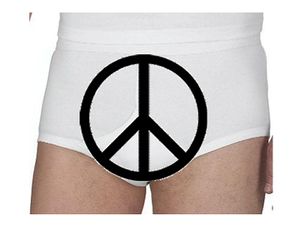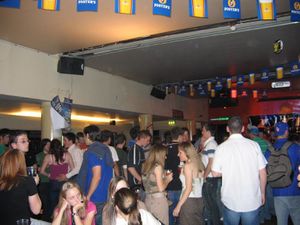Student Protest Movement
The Student Protest Movement is a league of gentlemen drawn from the upper echelons of society and the world of businesses. The media, in collusion with the movement, have developed a cover-story which portrays a militant anarcho-socialist organisation under the control of naive middle class students funded by Moscow. Historically, the movement has been content to lay dormant for long periods before mobilising to save the nation from the inevitable crisises engineered by wrong-thinking liberals.
The Student Protest Movement rose to prominence during the early 1960’s after a loose alliance of direct action groups was assembled under the leadership of the upper classes and Watney Mann Brewery. The movement has from time to time joined forces with a number of organisations when the Empire has been in peril. These have included:
- National Union of Students
- Socialist Workers Party
- Greenpeace
- CND
- IRA
Common tactics include the 'sit-in' whereby the students occupy university buildings. It is unusual for these 'sit-ins' to last longer than four days. By coincidence, the University Council of Great Britain sets a minimum attendance requirement of four days in order to pass a degree. Off-campus demonstrations are held in London due to its proximity to Kensington, where the students live and the City of London where global businesses are situated.
The Student Protest Meeting is headquartered in Kettering, England.
Origins & Funding[edit | edit source]
Since its inception, the coalition has been primarily funded by Watney Mann (latterly Grand Metropolitan) Brewery. During the early 1960's, Watney-Mann had invested several million pounds and gambled the company's future on their 21st Century keg bitter, 'Red Barrel' [1]. The product was declared a failure soon after launch, leaving the business in a precarious financial position. The failure was to a large extent caused by sly foreigners who had begun to contaminate the UK with lager in a typically foreign underhand manner. It should be noted that the failure of 'Red Barrel' was not in any way related to its resemblance to fizzy, brown piss.
Red Barrel was made to a closely guarded secret recipe which contained 74% out of date coca-cola, 1.5%Vinegar, 2.9% Heroin, 0.037%LSD and 48% of the Greenhouse gas, carbon dioxide. Red Barrel therefore seemed a natural contender for the rapidly expanding student market. Clever marketing johnnies realised that investing in developing an addiction loyal following amongst students would provide guaranteed sales in perpetuity. An agreement was reached between Watney Mann and the NUS, whereby the chiefs of the NUS would receive kick-backs in exchange for Red Barrel's exclusivity at all student bars. The business relationship bore fruit as the world partied in the Summer of Love between January 1960 and December 1969.
As the 1970’s dawned, scientists began to wake-up to the advantages of Global warming. Watney-Mann became aware that the use of carbon dioxide in its product was environmentally damaging and embarked on a research programme to address the problem. Swiss scientists discovered that adding nice colours and oestrogen to the drink would counteract the Global warming effects of carbon dioxide. Red Barrel was quietly withdrawn from the market and the revised environmentally friendly formula was repackaged and launched as various brands of alcopops.
Recent concerns over the alcopops' chemical cocktail have prompted Watney Mann to fund studies by former East German athletics scientists. The studies have concluded that there is no relationship between the use of oestrogen in alcopops and:
- The increase in sales of male hair and skin care products over the past decade.
- Box office receipts for Brokeback Mountain
- The negligible popularity of war films (the study was carried out in Germany and it is recognised that this could possibly have affected the result)
Notable Student Protest Campaigns[edit | edit source]
Since its inception in the 1960's, the student protest movement has mobilised to save the nation in every single decade. The rationale underlying these struggles to defend the British way of life are outlined below.

| 1960's | Nuclear weapons: Campaign for Nuclear Destruction | This campaign was driven by a the realsation that Britain was being too slow in developing a deployable atomic weapon with a meaningful yield. The movement sprung into action after foreign communists in Russia and worse still colonials in the USA successfully developed deployable megaton range weapons. As the Sun began to set on the Empire there was disquiet that Britain would be denied the opportunity to deploy nuclear weapons against the fuzzi-wuzzies. |
| 1970's | Fur coats: Animal Rights Movement | In the 1970's fur coats became affordable to the lower classes following the surge in popularity of the Canadian national sport of seal clubbing. The availability of fur coats made it difficult to distinguish between genuine blue blooded girls and high class hookers. This lead to a number of society scandals where blue blooded girls were inadvertently underpaid for their services. |
| 1980's | Poll Tax Riots | This campaign arose out of something of an error, though more likely deliberate mis-information from the Liberal world conspiracy. It was widely understood that the proposed tax would be levied against the employment of cheap domestic servants from Poland. With the passage of time the protest has been recognised as being right albeit for the wrong reasons. If Poles had been subject to an excess tax then the country today wouldn't be awash with communists from eastern Europe. In retrospect, the movement regard this as something of a Pyrrhic victory. |
| 1990's | Live Animal Exports | The protests against animal exports was underlain by a fundamental principle. For many years, the lower classes had been encouraged to donate 50p a month to Oxfam in order to provide foreigners a bowl of rice to eat each week. Not content with gorging themselves on free rice, foreigners then began to demand British livestock to eat. Foreigners taking advantage of the lower class in such a way was just not acceptable ; only British people should be permitted to exploit the lower orders - animal exports simply had to be stopped. Moreover, foreign johnnies particularly Diego's tend to spoil good meat by fighting with it; throwing it off church towers, or crushing it under the weight of the 10 fattest men in the village.[2] |
| 2000's | Stop The War | The Crusades of the last decade have been misdirected in that they have failed to target the real trouble maker in the region - Isreal. Arab countries tend to have well ordered societies where wealth is concentrated in the hands of a few individuals who know how to party and build giant phallic buildings. |
| 2010's | Student Loans | The £9K a year tuition fee cap is simply too low. If it is not raised significantly, it would allow the number of poor people attending university to continue to rise. Studies by Swiss scientists provide incontravertable evidence of a link between rising global temperatures and the number of poor people in tertiary level education. |
Traditions & Cultural Impact[edit | edit source]
Naming Student Bars After Foreign Communists[edit | edit source]
Throughout its history the student protest movement has been to the fore in pressurising evil non-British foreign dictatorships who imprison terrorist Nobel Peace Prize nominees. The movement places unbearable pressure on evil foreign governments by naming student bars after imprisoned Nobel Peace Prize nominees.
The most notable success was with South African, yellow, pygmy, terrorists Nobel Peace Prize winner Nelson Mandella. The evil apartheid regime capitulated and released Mandella after a mere 27 years, by which time the brave students had fearlessly named 1376 'Nelson Mandela Bars'.
In modern times, with globalisation of the world economy, dissidents are invariably Japanese, Korean or other types of Chinese. This presents some difficulties where student bars have to be named after dissidents with incredibly long names that cannot be adequately spelled out in the Roman alphabet. In the 1990’s many student bars were extended solely to accommodate the name of the currently fashionable dissident. At the same time, it became fashionable for students to tatto themselves with pictograms they believed commemorated an executed political prisonner but which invariably read "Gentlemen's Toilet" to Chinese speakers.
Latterly a more sustainable solution has been found. It has the added benefit of limiting the disruption and inconvenience caused by working class people reconstructing student bars. Dissident names are now made up using the last 15 letters left in the bag during a game of Scrabble. Students on their gap year then travel to different parts of China, like Thailand where they simply locate and persuade a common criminal to change their name to whatever came out of the Scrabble bag. A phone call to The Grauniad quickly accords the randomly selected criminal the status of a Nobel Peace Prize nominee.
Y-Fronts[edit | edit source]

The Campaign for Nuclear Destruction wing of the student protest movement is responsible for popularising the iconic 20th Century undergarment ‘Y-Fronts’.
In the early 1960's the nuclear weapons industry was dominated by amateur scientists committed to Victorian Liberal doctrine and 19th Century underwear. Development of viable weapons proceeded at a snail's pace. It was feared that leaving the county's offensive capabilities in the hands of such bumbling amateurs would cause Britain to fall behind advanced nations, like India in the nuclear arms race.
With the Empire rapidly diminishing, Britain was running out of safe places to test nuclear weapons. The nascent science of Sociology had recently proven beyond doubt that wearing racier underpants improved scientific output, but the government of the day, blinded by the white heat of technology, were unable to hear. France had already implemented a programme of compulsory 'Speedo's' for their nuclear scientists, and sex-crazed Italy had begun development of the 'Thong'. The race to save Britain was on.
The Student Protest Movement organised a popular movement, the Campaign for Nuclear Destruction. CND aimed to accelerate the development and testing of nuclear weapons ahead of India via the employment of modern scientists sporting 'Y-Fronts'.
The instantly recognisable CND logo is based on an early blueprint for 'Y-Fronts' recovered from the Nazi's after the end of the Second World War. ‘Y-Fronts’ remained de rigueur amongst student fashionistas until May 2010 when the Sunday Telegraph magazine announced the discovery of boxer shorts.
Pot Noodle[edit | edit source]
Pot Noodle was originally launched by the student movement as 'Pol Pot Noodle' in order to raise funds for the much misunderstood Khmer Rouge leader following his successful campaign to reduce university overcrowding in his native country.
Pol Pot had been influenced by his traumatic experiences as a university student in Paris. French liberal education policies had lead to serious over-crowding in the universities. Pol Pot spent his entire three year degree course as one of 18 students being lectured in a 2CV which formed an annex to the Sorbonne. (The student tradition of cramming, in excess of a dozen people, into a small car, is carried out as a homage to Pol Pot.)
On his return to the part of China called Cambodia, Pol Pot began to address overcrowding amongst the intelligensia in his native land. Pol Pot's good work was discovered by British students on their gap year visit to different parts of China. The 'Pol' was later dropped from the brand name in order to reduce Global warming.
Ugly Lesbian Looking 'Wimmin'[edit | edit source]
The Student Protest Movement provides a three to four year placement for ugly 'wimmin' under a long standing sponsorship agreement with Peter Stringfellow. The agreement was originally brokered by Peter Stringfellow in 1967 in reaction to a steadily declining trade in his nightclub business.
Research by Nobel Prize winning Swiss scientists had revealed the key to declining sales; the previously undocumented '2:30 birds' phenomenon. Observations concluded that after a night drinking foreign lager, young British working class males, were susceptible to 'kopping off' with ugly 'wimmin' in nightclubs at closing time. The male victim (and his chums) would then avoid the nightclub for a period of weeks causing the drop in trade.
Stringfellow's situation eased somewhat in 1973 after the invention of the kebab, but the increased sales resultant from nightclubs devoid of ugly 'wimmin' lead to a perpetuation of the arrangement.
The Present Day[edit | edit source]
The student protest movement grabbed the front pages once again in late 2010. The headlines involved His Royal Highness The Prince of Wales and Camilla Parker Bowles on Oxford Street.
The Royal Couple's regular Thursday night Oxford Street dogging had been captured by a foreign newspaper photographer. In the interests national security, it was necessary to invent a cover story involving student riots. Within 10 minutes of receiving a phone call from Her Majesty The Queen, the student protest movement was able to mobilise over 4,000 individuals to stage a mock riot. For many members of the establishment this marks the Student Protest Movement's finest hour.
In a nod to the Student Protest Movement's heroic action, the British press ran a knowing article euphemistically described the limousine as being covered in 'white paint' following a 'riot' .








